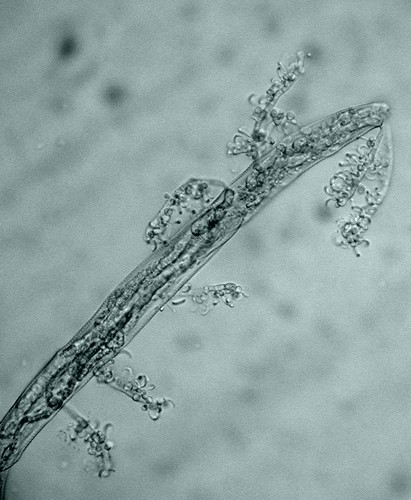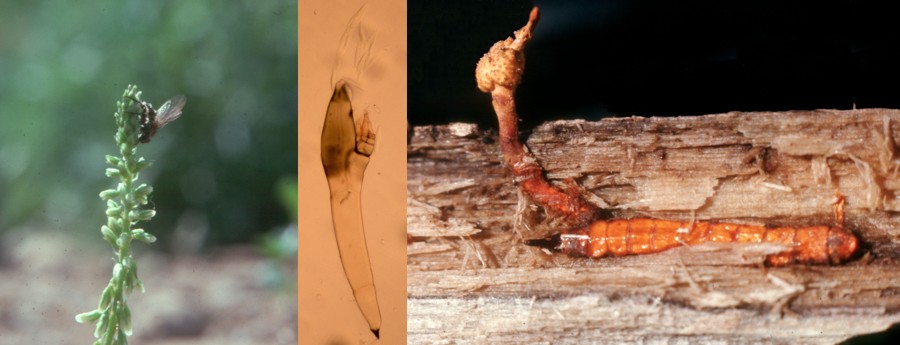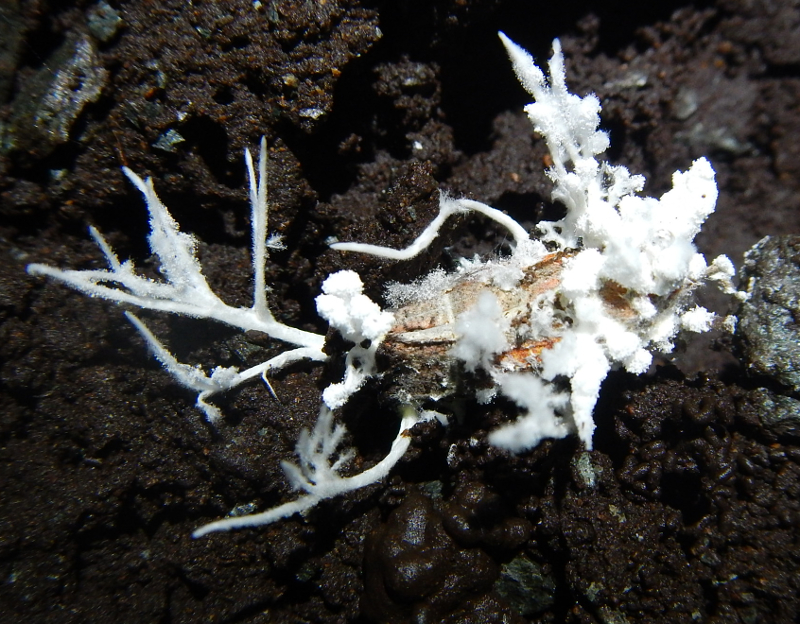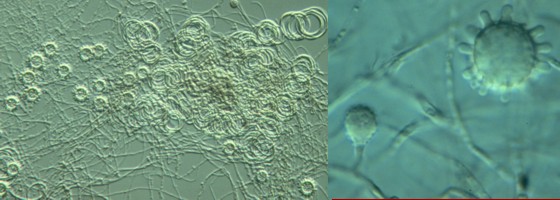Home >> Where fungi grow >> Parasites >> Fungal parasites of animals
FUNGAL PARASITES OF ANIMALS
Fungi are able to grow parasitically on a great variety of animals. In fact, it would be difficult to find an animal that doesn't have fungal parasites. When a biologist speaks of animals he or she doesn't just mean the big things like lions, tigers, dogs, cats and elephants. To a biologist an animal is any organism that is multicellular, non-photosynthetic and digests its food inside its body. This definition differentiates animals from plants and fungi. It also excludes (with some intriguing exceptions) the multitude of simple organisms that we now know to be genetically only distantly related to the three large groups.
Biologically speaking the kingdom of animals includes everything from the tiniest microscopic beings to large vertebrates, including ourselves. With such a wide variety of organisms to colonize it's not surprising that parasitic fungi come in a great variety of forms and have an equally great diversity of methods to do their work. It is also not surprising that the ones attacking worms or insects are quite different from those attacking birds or humans. Because of this division of labour among parasitic fungi we will examine them according to the group they attack.
INVERTEBRATE ANIMALS
An invertebrate animal is an animal without a backbone. This includes an immense diversity of organisms ranging from such simple things as corals, sponges and jellyfish to more complex animals like insects and lobsters. Of the approximately 1 million animals known to science about 950,000 (95%) are invertebrates. In fact the group is so large and complex that it would only be possible to discuss their fungal parasites in detail by subdividing it further. Instead we will examine a few examples.
Nematodes
Nematodes or roundworms comprise a large group of animals found in almost every habitat on earth. They are exceedingly numerous. Prof. E. O. Wilson has stated that if the surface of the earth were suddenly removed its shape could still be discerned by the ghostly outline of living nematodes. Four out of five species of animals are nematodes and most of these remain unnamed. With such a mass of living organisms we should not be surprised to learn that many fungi are able to use them as a source of nutrition. Several groups of fungi are specialized for detecting, infecting and consuming these little worms.
Fungi attacking nematodes are often divided into two functional groups, the endoparasites and the predators. Endoparasitic fungi develop entirely within the nematode and really have no life outside the animal while the predacious ones grow extensively in environments rich in nematodes and lay various sorts of traps to capture them.

The picture at right depicts Harposporium anguillulae, a typical and common endoparasitic form. The large banana-shaped structure running diagonally from lower left to upper right is a single nematode. Numerous hyphae of H. anguillulae can be seen inside its body giving rise to spore-bearing structures that have broken through the nematode's cuticle and are producing sickle-shaped conidia (asexual spores). This nematode was orginally obtained from a sample of garden soil where it had been foraging for bacteria, fungal spores and other small bits of nutrition. In the process of this indiscriminant feeding it had ingested one or more of the sharp, curved conidia of H. anguillulae which had become lodged in its oesophagus. The conidia had then germinated and produced the hyphae filling the nematode's body. Recent research has shown that species of Harposporium are in fact asexual forms produced by species of the ascomycete genus Podocrella. This is of great interest to mycologists because Podocrella species, members of the family Clavicipitaceae, are parasites of insects and other arthropods. This means that Podocrella species are among several groups of parasitic organisms that depend upon two or more hosts (prey) in their life cycles.

Predaceous fungi employ a variety of means to capture nematodes. These fungi grow abundantly in habitats where nematodes are abundant, producing modified sticky branches that adhere to the nematode cuticle. When a nematode comes into contact with one of these branches it gets stuck and cannot get loose. These special structures may take the form of simple short branches, knobs or loops. In some cases they have the ability to close down and form a strangle-hold on nematodes that attempts to pass through them. The picture at left shows a nematode caught by a species of the nematode-trapping fungus Orbilia. The picture above shows the traps themselves, a series of sticky loops and arches place strategically in the path of potential prey.
Insects
Insects live among fungi, pushing their way through hyphal masses and brushing against their spores. Many insects even eat fungi. With such close contact between insects and fungi is is not at all surprising that some fungi have developed the ability to live as parasites on insects. Like the fungi that attack nematodes many of those attacking insects are highly specialized and have sophisticated means of locating and infecting their prey. They may also be host-specific and occur on a few or even single species of insect.
The number and diversity of fungi parasitic upon insects is so great that is is impractical to try to deal with it here. Instead we will discuss a few characteristic types and leave it to you to delve more deeply into the subject.

Of the many fungi infecting insects three groups stand out as especially numerous. These are the orders Entomophthorales, Laboulbeniales and Clavicipitaceae. The picture above illustrates these three common groups. At the left is Entomophthora muscae a common parasite of flies in our area. Infected flies often land on an upright plant stem, turn bottom up and die. The parasite, which has been growing inside the insect, grows out of its recently killed prey and produces masses of white spores along each of the abdominal segments. You can easily find this fungus in the garden during late summer. Just look for grasses or other plants with an inverted dead fly clinging to ther tops. If the fungus is not obvious, place the fly on a piece of glass or plastic food wrap and enclose it so it will not dry out. By morning you will have a halo of spores surrounding the fly.
The middle picture is of Laboulbenia philonthi, a member of the Laboulbeniales. Members of this group grow attached to the outside of the insect; the black structure at the bottom is the point at which it is attached. although external, the fungus does have an absorption cell called a haustorium inside the insect at the point of attachment. although clearly parasitic the Laboulbeniales probably do little harm to their hosts. They are equivalent to fleas and ticks on mammals
The fungus at right is Cordyceps variabilis. It was infecting the larva of a beetle inside a dead log, which has been cut away to show the relationship between host and parasite. Cordyceps, a member of the Clavicipitaceae, produces its spores inside the swollen head-like structure above the log. The Clavicipitaceae are fairly common in temperate parts of the world but become exceedingly abundant in the tropics.

The picture at right shows a dead moth colonized by the fungus Cordyceps bassiana. This one was photographed by Karen Vanderwolf in a cave in New Brunswick where it was growing at a temperature lower than 10 degrees C. This fungus is known to produce a sexual stage typical of the Clavicipitaceae. In fact, that stage was found for the first time in 2001. The asexual form, shown here and known as Beauveria bassiana, has been recognized since the early nineteenth century when the Italian mycologist Agostina Bassi demonstrated it to be the cause of 'muscardine disease' in silkworms.
VERTEBRATE ANIMALS
Vertebrate animals can serve as hosts for parasitic fungi. although vertebrates make up only a small part of the animal kingdom they display a some diversity in both aquatic and terrestrial habitats. Aquatic habitats support quite different kinds of fungi than terrestrial ones so it is not surprising that fish and amphibians harbour fungal parasites having little in common with those infecting birds and mammals.
Fish
Most of the fungi parasitizing fish are not really fungi at all and instead belong to the phylum Oomycota. although once thought to be fungi we now know that the Oomycota and more closely related to certain algae. For more information about this group of "non-fungal fungi" see the section on Oomycota. Species of several genera of Oomycota are known to attack fish. Home aquarium owners will undoubtedly recognize the genus Saprolegnia, a notorious group of parasites that can wipe out an aquarium in a short period of time. Species of Saprolegnia get into the fish through open wounds and rapidly penetrate its tissues with broad tubular hyphae. Infected but still-living fish may be seen swimming with a tuft of hyphae trailing out behind them. The next time you visit a pet store have a look at the fish medicines; many claim effectiveness against Saprolegnia.
A few "true" fungi also parasitize fish, including some species of Exophiala and Fusarium. although we usually think of Fusarium species as plant parasites they can become parasitic on a variety of animals, including humans.
Amphibians
Amphibians, including frogs, toads, newts and salamanders, may be air-breathing in their adult stages but generally are not very resistant to dryness and must remain in aquatic or very moist habitats. Because of the moisture that usually surrounds them they are susceptible to many of the same parasites as fish. Even woodland salamanders can be infected with species of Saprolegnia.
More recently biologists have begun to experience severe declines in the populations of frogs in many parts of the world. although the cause of this decline is still not entirely understood a major factor appears to be the the fungus Batrachochytrium dendrobatidis which infects the skin of frogs causing severe leasons and finally death. The disease is called chytridiomycosis. Batrachochytrium dendrobatidis is a member of the Chytridiomycota, a group of true fungi having motile spores that can swim in search of aquatic prey. Why this fungus has become prevalent in just the last few years is not clear. Scientists have suggested global warming, pollution, habitat disturbance and other causes but the answer is still not known.
Birds and mammals are together a smaller group than fish, and of these birds are the more numerous. Apparently swimming and flying are the way to success! These terrestrial, warm-blooded animals have a variety of fungal parasites. Of course the ones infecting humans and domestic animals are the best-known while those parasitic on wild mammals and birds remain largely unstudied. There are several excellent sites on the internet discussing these fungi in detail and presenting what some may find to be rather alarming photographs.
The fungi causing mycoses or diseases in birds and mammals are often divided into several groups depending upon the site of infection. These groups are:
Superficial mycoses
These are fungi that grow on the surface of the body or on hair shafts. They do not invade living tissues and usually cause no symptoms. They may often be present but undetected. One of the most common of these is Malassezia furfur, a relative of the smut fungi which may cause a mild dermatitis or discolouration of the skin. It can also be the cause of dandruff.
Cutaneous mycoses
A very common group of fungi found in the outermost layers of dead skin. although they do not invade living tissues they produce enough enzymes and other metabolites in the outer layers of skin that they elicit a response in the host that is usually seen as reddening at the site of infection. These fungi, commonly called dermatophytes, are the cause of athlete's foot, ringworm and nail disorders. Candida albicans, a member of this group that also grows on mucus membranes in the mouth, anus and vagina can cause more serious infections under certain conditions.
Subcutaneous mycoses
This is a group of fungi that are probably not primarily parasitic and only become so if they enter a wound. Generally they remain localized and form small masses of hyphae in the affected tissues. They may at times invade bones. Subcutaneous mycoses may remain on the host for many years and form leaky swollen lesions.
Dimorphic systemic mycoses

Fungi in this group are called dimorphic because they can grow as hyphae or in a single-celled budding form, depending upon where they are. In a petri dish at room temperature they grow as "normal" hyphal colonies but in living tissue they begin to behave like yeasts and travel through the body as single cells. They are called systemic because they have the ability to spread to various organs. Typically the spores are inhaled with dust and germinate to form colonies in the lungs. They may remain there and cause tuberculosis-like symptoms or they may spread to other parts of the body. The diseases they cause can be serious or even fatal. Members of this group tend to be quite common in certain endemic areas and quite rare elsewhere. The picture at right is of Ajellomyces capsulatus, the fungus responsible for histoplasmosis, a disease prevalent around the southern Great Lakes and St. Lawrence Valley. On the left side of the picture are several small round objects; these are the asexual spores of the fungus and are commonly called Histoplasma capsulatum. The panel on the right side of the picture shows these spores close-up where you can plainly see the characteristic "fingers" extending out from the surface. To the right of the left panel is a mass of hyphae and bedspring-like coils. This is where the sexual ascospores are produced.
Opportunistic systemic mycoses
This group includes fungi that are able to invade tissues within the body but are not dimorphic. They are opportunistic because they normally exist as non- parasitic forms and only become virulent when the immune system has been compromised in some way. This can occur through the use of immunosuppressant drugs following organ transplant surgery or because of diseases such as AIDS and diabetes that suppress the immune system. The use of chemotheraputic agents, corticosteroids and other chemicals having a profound effect on the body may also allow them entry. These fungi are not in any kind of "balance" with the host and can invade rapidly and destructively.